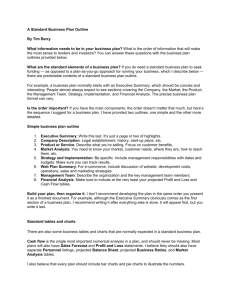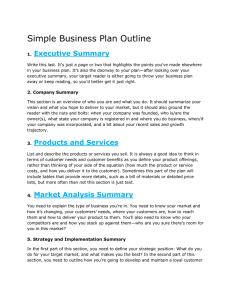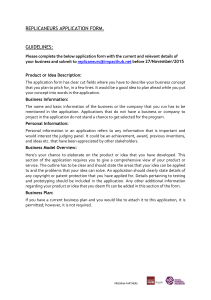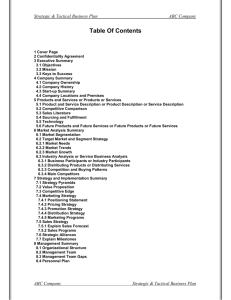What is a Business Plan
advertisement
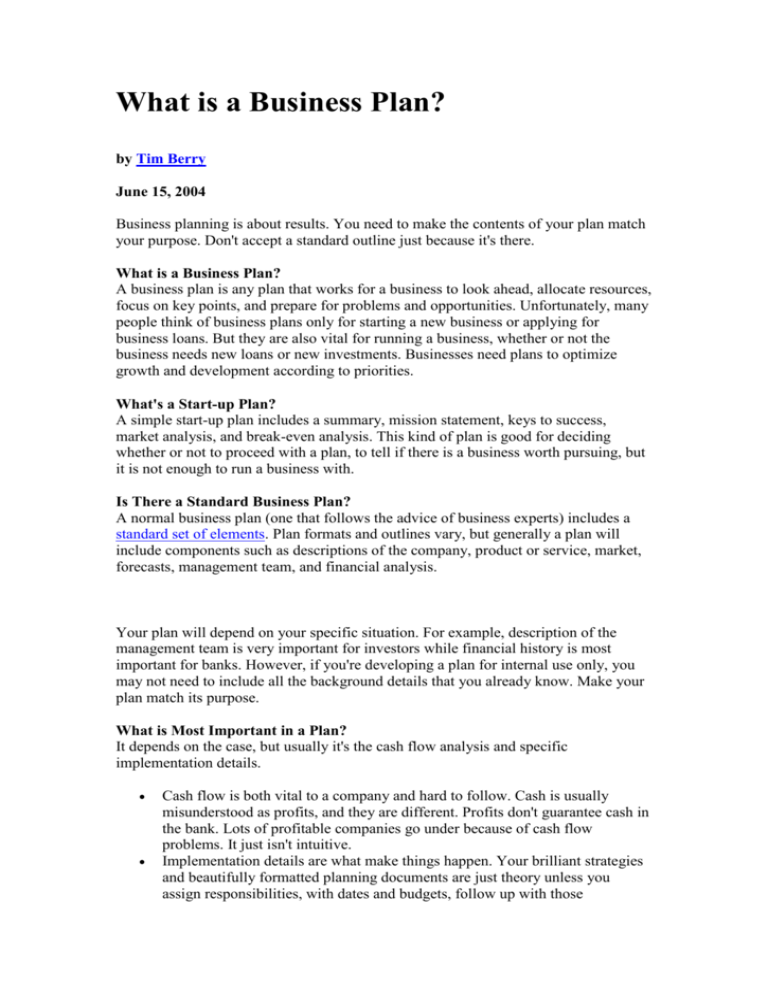
What is a Business Plan? by Tim Berry June 15, 2004 Business planning is about results. You need to make the contents of your plan match your purpose. Don't accept a standard outline just because it's there. What is a Business Plan? A business plan is any plan that works for a business to look ahead, allocate resources, focus on key points, and prepare for problems and opportunities. Unfortunately, many people think of business plans only for starting a new business or applying for business loans. But they are also vital for running a business, whether or not the business needs new loans or new investments. Businesses need plans to optimize growth and development according to priorities. What's a Start-up Plan? A simple start-up plan includes a summary, mission statement, keys to success, market analysis, and break-even analysis. This kind of plan is good for deciding whether or not to proceed with a plan, to tell if there is a business worth pursuing, but it is not enough to run a business with. Is There a Standard Business Plan? A normal business plan (one that follows the advice of business experts) includes a standard set of elements. Plan formats and outlines vary, but generally a plan will include components such as descriptions of the company, product or service, market, forecasts, management team, and financial analysis. Your plan will depend on your specific situation. For example, description of the management team is very important for investors while financial history is most important for banks. However, if you're developing a plan for internal use only, you may not need to include all the background details that you already know. Make your plan match its purpose. What is Most Important in a Plan? It depends on the case, but usually it's the cash flow analysis and specific implementation details. Cash flow is both vital to a company and hard to follow. Cash is usually misunderstood as profits, and they are different. Profits don't guarantee cash in the bank. Lots of profitable companies go under because of cash flow problems. It just isn't intuitive. Implementation details are what make things happen. Your brilliant strategies and beautifully formatted planning documents are just theory unless you assign responsibilities, with dates and budgets, follow up with those responsible, and track results. Business plans are really about getting results and improving your company. Can you Suggest a Standard Outline? If you have the main components, the order doesn't matter that much, but here's the outline order we suggest in Business Plan Pro software: 1. 2. 3. 4. Executive Summary: Write this last. It's just a page or two of highlights. Company Description: Legal establishment, history, start-up plans, etc. Product or Service: Describe what you're selling. Focus on customer benefits. Market Analysis: You need to know your market, customer needs, where they are, how to reach them, etc. 5. Strategy and Implementation: Be specific. Include management responsibilities with dates and budget. 6. Management Team: Include backgrounds of key members of the team, personnel strategy, and details. 7. Financial Plan: Include profit and loss, cash flow, balance sheet, break-even analysis, assumptions, business ratios, etc. A Standard Business Plan Outline by Tim Berry July 20, 2004 There are predictable contents of a standard business plan. For example, a business plan normally starts with an Executive Summary, which should be concise and interesting. People almost always expect to see sections covering the Company, the Market, the Product, the Management Team, Strategy, Implementation and Financial Analysis. If you have the main components, the order doesn’t matter that much, but here’s the order I suggest. 1. Executive Summary: Write this last. It’s just a page or two of highlights. 2. Company Description: Legal establishment, history, start-up plans, etc. 3. Product or Service: Describe what you’re selling. Focus on customer benefits. 4. Market Analysis: You need to know your market, customer needs, where they are, how to reach them, etc. 5. Strategy and Implementation: Be specific. Include management responsibilities with dates and budgets. Make sure you can track results. 6. Web Plan Summary: For e-commerce, include discussion of website, development costs, operations, sales and marketing strategies. 7. Management Team: Describe the organization and the key management team members. 8. Financial Analysis: Make sure to include at the very least your projected Profit and Loss and Cash Flow tables. I don’t recommend developing the plan in the same order you present it as a finished document. For example, although the Executive Summary obviously comes as the first section of a business plan, I recommend writing it after everything else is done. It will appear first, but you write it last. Standard Tables and Charts There are also some business tables and charts that are normally expected in a standard business plan. Cash flow is the single most important numerical analysis in a plan, and should never be missing. Most plans will also have Sales Forecast and Profit and Loss statements. I believe they should also have separate Personnel listings, projected Balance sheet, projected Business Ratios, and Market Analysis tables. I also believe that every plan should include bar charts and pie charts to illustrate the numbers. Expanded Plan Outline 1.0 Executive Summary 1.1 Objectives 1.2 Mission 1.3 Keys to Success 2.0 Company Summary 2.1 Company Ownership 2.2 Company History (for ongoing companies) or Start-up Plan (for new companies). 2.3 Company Locations and Facilities 3.0 Products and Services 3.1 Product and Service Description 3.2 Competitive Comparison 3.3 Sales Literature 3.4 Sourcing and Fulfillment 3.5 Technology 3.6 Future Products and Services 4.0 Market Analysis Summary 4.1 Market Segmentation 4.2 Target Market Segment Strategy 4.2.1 Market Needs 4.2.2 Market Trends 4.2.3 Market Growth 4.3 Industry Analysis 4.3.1 Industry Participants 4.3.2 Distribution Patterns 4.3.3 Competition and Buying Patterns 4.3.4 Main Competitors 5.0 Strategy and Implementation Summary 5.1 Strategy Pyramids 5.2 Value Proposition 5.3 Competitive Edge 5.4 Marketing Strategy 5.4.1 Positioning Statements 5.4.2 Pricing Strategy 5.4.3 Promotion Strategy 5.4.4 Distribution Patterns 5.4.5 Marketing Programs 5.5 Sales Strategy 5.5.1 Sales Forecast 5.5.2 Sales Programs 5.6 Strategic Alliances 5.7 Milestones 6.0 Web Plan Summary 6.1 Website Marketing Strategy 6.2 Development Requirements 7.0 Management Summary 7.1 Organizational Structure 7.2 Management Team 7.3 Management Team Gaps 7.4 Personnel Plan 8.0 Financial Plan 8.1 Important Assumptions 8.2 Key Financial Indicators 8.3 Break-even Analysis 8.4 Projected Profit and Loss 8.5 Projected Cash Flow 8.6 Projected Balance Sheet 8.7 Business Ratios 8.8 Long-term Plan Source: http://www.bplans.com/

